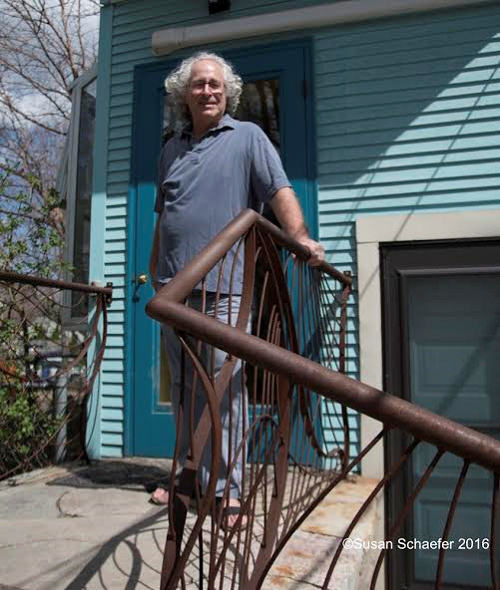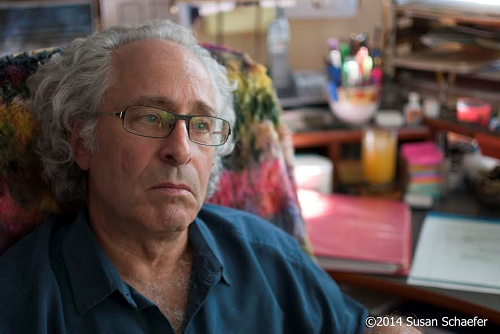Marcy Holmes’ Creative Genius: Composer, Performer, Activist Craig Harris
 Monday, April 18, 2016 at 4:55AM |
Monday, April 18, 2016 at 4:55AM |  Susan Schaefer |
Susan Schaefer | By Susan Schaefer
A far cry from Vienna, London, New York or Paris, in the Marcy Holmes neighborhood on the East Bank of the Mississippi, a group of “Left Bank” artist types doggedly persist amongst the University of Minnesota student party houses. There, in a Robin’s egg blue house filled to the brim with objects and artifacts of prodigious artistic output lives Craig Harris, Interference Arts Artistic Director, a creative genius worthy notoriety in any of these great global cultural centers.

Harris, along with his wife, multimedia textile artist, costumer and photographic illustrator, Candy Kuehn, build community with their creativity. Frequent collaborators, Harris and Kuehn have raised two daughters in Marcy Holmes where they are heralded as partisans. However, their artistic reputations extend deeply into the greater Twin Cities creative communities.
An artist of Harris’ caliber often chooses to focus on his solo artistic career, but that is antithetical to his staunch community activist mantle. Part of what fuels Harris’ right brain creative virtuosity are his astounding left brain logic and strategic abilities, which he has plied generously to support numerous local, national and international cultural institutions.
As Executive Director of Ballet of the Dolls, and as initiator of the Ritz Theater renovation, Harris is credited for pioneering the transformation of the surrounding Northeast Sheridan neighborhood into a cultural mini-mecca. His work as interim director of Seward Neighborhood’s Playwright Center, and more recently for such regional arts organizations as Open Eye Figure Theater, Marcy Arts Partnership and Caponi Art Park, garners high praise.
At the forefront of several creative waves, including computer music development and the electronic arts evolution, Harris also has contributed to such international organizations as the International Society for the Arts, Sciences and Technology, and The International Computer Music Association.
An earnestly contemplative façade and self-effacing manner belie Harris’ boundless talent and yeoman’s energy.
His theatrical mastery composing music, writing scripts, and building environments in what he terms multimedia dramatic realms was visible two weekends ago at the world premiere of Elijah in the Wadi, his latest creative project, in part made possible through The Right Here Showcase staged at The Illusion Theater on Hennepin Avenue.

Harris, a native of Rochester, New York, spoke to me about aspects of his life and work.
Why do you live and work in Marcy Holmes specifically?
When we moved here from San Francisco with our two little girls we were seeking a family friendly place where we would know our neighbors, and be able to have our kids in a vibrant public school where the community was fully engaged. With two artist parents who mainly work out of the house, we also needed to find an affordable house that would be large enough to have two studios as well as satisfy normal family living requirements. We wanted to be located in an urban setting where we could easily partake in the active artistic environment in Minneapolis. Marcy Holmes met all of these qualities so completely that it was a natural fit for us – great neighborhood, a good sized home for the family and studios, Marcy Open School for the kids, close to the river, close to downtown, easy access to public transportation and highways.
With so much experience with regional art here, what are your reflections on the Twin Cities art community?
The Twin Cities art community is quite vital for a variety of reasons, all of which really need to be in place for the ecosystem to function well. First, there is long history of recognition in the philanthropic community of the value of local cultural and artistic expression.
Then there is a diversity of artistic engagement within and across traditional boundaries – performing arts (theater, music, dance), visual arts, etc., and a diversity of participation – individual artists; small and large groups of artists; small, medium and large organizations providing a level of activity that provides both vitality and opportunity.
Of course, the cost of living here makes it more viable to create a life as an artist than is realistic in most urban settings; and we are blessed with a public interested in exploring and engaging in artistic expression.
I’d like to know more about your latest effort. Elijah feels like a highly personal piece of theater – is it?
My primary focus in all of my work is the exploration of personal engagement in society: who are we as individuals with deep personal needs for expression, growth and active participation; and how do we effectively integrate the individual and personal with the needs of society at large. How do we navigate the sometimes challenging terrain of balancing our personal and society realms of existence?
It seems fitting that your show debuted so close to the Jewish Holiday of Passover (that begins this coming Friday at sundown) where the Prophet Elijah plays a prominent role. What are the most critical themes you tackle in Elijah and why? Specifically, what do you hope is the audience’s takeaway?
I describe the Prophet Elijah as being a witness and an activist. He is a witness to some very large-scale transformations in the civilization of his time, and he also is witness to some very personal exchanges among individuals who manifest the full gamut of human beauty and conflict on both personal and societal levels.
In the Bible, Elijah is called to be an activist – to carry the mantle to try to make change for the public benefit – and yet he has significant challenges in being able to actually make a difference.
This is the nexus of my message – even when he doesn’t seem to be able to make the needed change, he still tries. He doesn’t give up, and he is even at times able to find joy in the journey. I want the audience to see themselves in Elijah – to witness, to be actively engaged, and to find joy in the journey even amidst life’s challenges.
Please discuss the multimedia elements of this and how vital they are to the stage presentation.
My work is envisioned, written and realized in a multimedia dramatic realm, much like how I believe we actually experience the world as individuals, with complex visual, sonic and experiential input; linear and non-linear narrative elements, and symbolic characteristics. We take in all of this complex information, process it internally, and then translate it into what turns out to be a highly personal world view that affects how we engage with the world.
To be effective in communicating, I need to engage with people who are highly experienced and effective in their own realm of work (visual projection, costumes, sonic expression) and diverse enough in their backgrounds to be able to collaborate well with others – to see the total picture with sufficient clarity to be able to integrate elements into a cohesive whole.
Do you Have hopes for national and international exposure for Elijah?
I created Elijah in the Wadi to be a touring show that could be produced fully – with all visual projections, lighting and multi-channel sound environment – and also be produced easily in smaller scale versions that could incorporate the single actor with music or a less expansive visual panorama.
My hope is that we can find widespread exposure both nationally and internationally for this show. I would love to take this show to the Middle East. I have other multimedia dramatic works that I also would like to tour, and I have been working towards that goal. Elijah in the Wadi may be the entry point for the touring that could make it possible for me to take other work on the road as well. It’s definitely the goal.
Twin Citians interested in seeing Harris’ productions can check in at his website listed above to learn when Elijah or other productions will be produced again locally and to follow his work.
Susan Schaefer can be reached at susan@millcitymedia.org.
